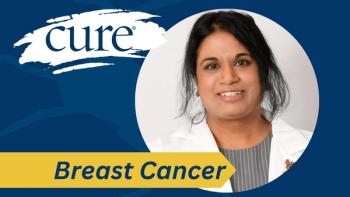
Adding S-1 to Endocrine Therapy Improves Survival in Japanese Patients with Breast Cancer
Results from a phase 3 trial showed significant increases in five-year invasive disease-free survival estimates among Japanese patients with hormone receptor-positive, HER2-negative breast cancer.
The addition of S-1, an oral fluoropyrimidine-based drug, to endocrine therapy administered after surgery improved invasive disease-free survival in Japanese patients with hormone receptor (HR)-positive, human epidermal growth factor receptor 2 (HER2)-negative breast cancer, according to phase 3 study results presented during a press briefing held at the annual meeting of the San Antonio Breast Cancer Society (SABCS) on Dec. 11, in San Antonio, Texas.
HR-positive, HER2-negative breast cancer is also referred to as luminal breast cancer, and is the most common breast cancer subtype, accounting for roughly two-thirds of all breast cancer cases.
HER2-negative disease describes breast cancer cells that do not have a large amount of a protein called HER2 on their surface, according to the National Cancer Institute. In normal cells, HER2 helps control cell growth, but cancer cells that are HER2 negative may grow more slowly and are less likely to come back or spread to other parts of the body than cancer cells that have large amounts of HER2 on their surface.
In the open-label, randomized, phase 3 trial led by Dr Masakazu Toi, a professor of breast surgery at Kyoto University Hospital in Japan, the researchers examined the efficacy of S-1 in combination with adjuvant endocrine therapy versus endocrine therapy alone in 1,939 patients who had stage 1 to 3 HR-positive, HER2-negative breast cancer with intermediate or higher risk of recurrence. The study took place across 139 centers in Japan and all patients were of Japanese ancestry.
S-1 dosage was chosen among 80 mg/day, 100mg/day and 120 mg/day, according to the body surface area of each patient, administered for one year with a 2 weeks on/1 week off administration schedule.
The primary endpoint of the study invasive-disease-free survival (the length of time after primary treatment for cancer ends that a patient survives without any signs of symptoms of that cancer). Secondary endpoints included disease free survival, distant disease-free survival, overall survival and the safety profile of the therapy.
Among the 957 patients who received S-1, 101 (10.6%) experienced disease recurrence, compared to 155 (15.9%) of the 973 patients in the control arm. The estimated five-year invasive disease-free survival was 86.9% for patients administered S-1, and 81.6% in the control arm.
“We found that the postoperative adjuvant use of S-1 in combination with standard endocrine therapy significantly reduced (invasive-disease-free survival) events and improved five-year (invasive-disease-free survival) estimates in patients with HR-positive, HER2-negative breast cancer,” Toi said in a statement. “Our findings support the addition of S-1 to standard endocrine therapy in the post-operative adjuvant setting for patients with HR-positive, HER2-negative disease and an intermediate or higher risk of recurrence.”
While results appear positive, the study was limited by the fact that it was only conducted on Japanese patients, and the toxicity profile of S-1 could be slightly different between Asian and non-Asian patients. However, the trial uncovered no new side effects, and safety data in patients treated with S-1 was well tolerated and manageable.




